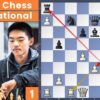The FIDE Women`s World Cup stands as a premier event in the global chess calendar, a rigorous knockout tournament that determines not only a champion but also contenders for the highest title. Notably, this edition is being held as a distinct event, separate from the Open FIDE World Cup.
Beyond the prestige of the title, the financial stakes are considerable. Players are vying for a share of a total prize fund amounting to $691,250 USD. The ultimate victor will claim a significant $50,000 prize. Yet, perhaps the most impactful outcome of the tournament is the awarding of three coveted places in the FIDE Women`s Candidates Tournament, scheduled for the first half of 2026. These spots are essential stepping stones for players aiming to challenge for the Women`s World Championship crown.
The format of the tournament is a straightforward knockout bracket across seven rounds. Each match consists of two classical games. If these two games do not produce a decisive winner, the contest proceeds to a series of tiebreaks.
Classical games are played under a time control of 90 minutes for the first 40 moves, followed by an additional 30 minutes for the rest of the game. A 30-second increment per move is applied from the very beginning, a standard feature designed to mitigate severe time pressure in critical phases.
When the classical portion ends in a tie, the real test of nerve and speed begins with the tiebreak stages. This escalating format demands versatility:
- The first stage involves two rapid games with a time control of 15 minutes per player, plus a 10-second increment per move.
- If still tied, two more rapid games follow at a faster 10 minutes + 10 seconds increment per move.
- Should the deadlock persist, the pace quickens further with two blitz games at 5 minutes + 3 seconds increment.
- If parity remarkably continues, two games at 3 minutes + 2 seconds increment are played.
- In the unlikely event that even these games don`t yield a winner, another 3+2 game is played with colors reversed from the previous game.
- If *that* game is drawn, the same single-game, color-reversed 3+2 procedure is repeated until a decisive result is finally achieved. It`s a technical descent into madness that perfectly illustrates the brutal efficiency of knockout chess.
This structure ensures that every match is a tense affair, with the potential for dramatic shifts in momentum, especially as the time controls shrink. The journey through the Women`s World Cup is a demanding test of skill, endurance, and composure under pressure, with significant rewards awaiting those who can navigate its treacherous waters.








